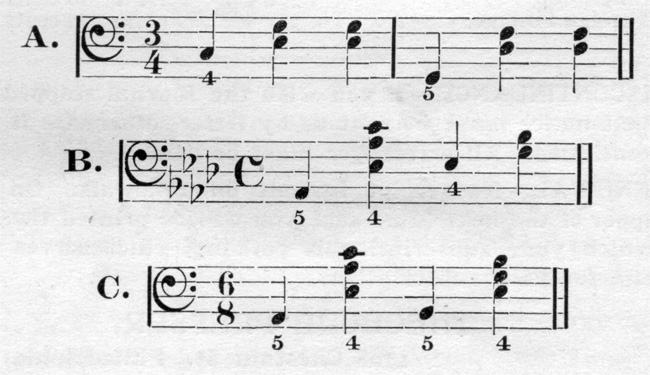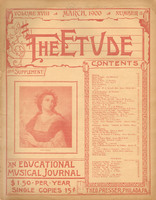Perhaps no problem in the education of the countless number of piano students confronts music teachers with more demand for its solution than the question of how best to cultivate the usage of the fourth finger. While its treatment in the right hand has been largely considered and touched upon, its significance in striking chords and bass notes in the accompaniment seems, in many cases, to have been under-estimated. It is the purpose of this article to call attention to several points that, while possibly viewed in the form of a distinct innovation, may, nevertheless, arouse the interest of all who have the furthering of piano-playing at heart, and, though it may be but one of the many small details that are crowding the subject of an already generous stock of piano literature, I feel sure that it will be conceded to be important, if not proving to be a question necessarily vital.
Prominent among the early difficulties that beset the average pupil is the secure guiding of the left hand to the bass notes. Even in the simplest accompaniment of a little waltz the touching of the tonic and dominant, followed by their respective chords, has been found to puzzle the beginner; and how often the wearisome striking of false notes, with the attendant admonitions of the teacher, causes the pupil to grow restless, and wonder why it is that piano-playing is so hard to learn! In the majority of cases this can easily be remedied by alternating the use of the little finger with that of the fourth. The reason of this is threefold. The Example A will help to make this plain.
Given a simple waltz accompaniment in C-major with the minor third E-G following the small C and the minor third D-F following the large G.
The pupil is now told by the teacher to strike the bass note C with the fourth finger and the dominant G with the fifth. What results? First, the pupil finds that the fifth finger is left prepared to seek out the low note independently of the other fingers, and also is nearer to it than would have been the case had he already used it to strike the C. Secondly, the proper position of the hand is unconsciously assured by using the fourth finger, and the feeling of necessity for strengthening the same is made apparent. Third, the compass of the octave is brought under better control, and security and precision results. Not alone this. The frequent and judicious employment of the fourth finger fills the young student with a feeling of a means of command. He is less apt to touch the keys with the side of the fifth finger instead of the tip, and he grows to realize that he has a resource upon which he may draw. And finally the fundamental position of the left hand is not so often changed. He at once realizes that the fifth finger backs up, as it were, the fourth.
This exceedingly natural scheme of using the fourth finger cannot but be obvious. To limit the little finger to the exclusive use of playing the bass notes would be like using the same foot exclusively in walking. It would be ridiculous to hop along with both feet at the same time, as well as being extremely awkward. Just as one foot is placed before the other exactly, so is it natural for the fifth finger to follow the fourth and vice versâ. When one considers the keys with the signatures of more than two sharps or flats (see Example B) the method cannot fail to appeal to the earnest musician as a practical one. Another abuse of the little finger of the left hand consists in utilizing it in playing the lowest note of a triad the compass of which does not extend over a sixth. The folly of thus using it is so clear that the following rule may be safely quoted (Example C): “The lowest note of chords written for the left hand, not exceeding a compass of a sixth, in their fundamental position or in their first inversion, should always be played with the fourth finger.” A careful perusal with a glance at the accompanying fingered illustrations, it is hoped, will not fail to prove useful to the reader, either in confirming his doubts or in arousing his thoughtful interest.




